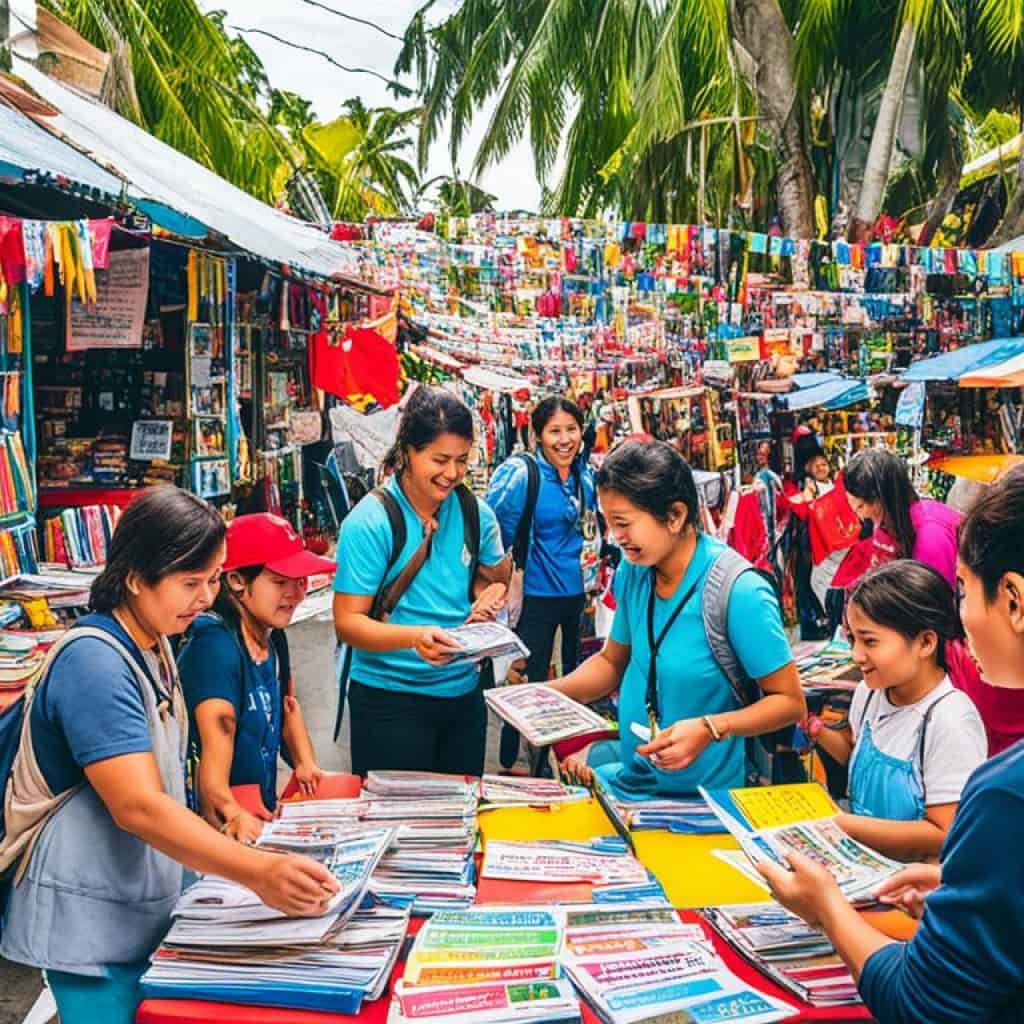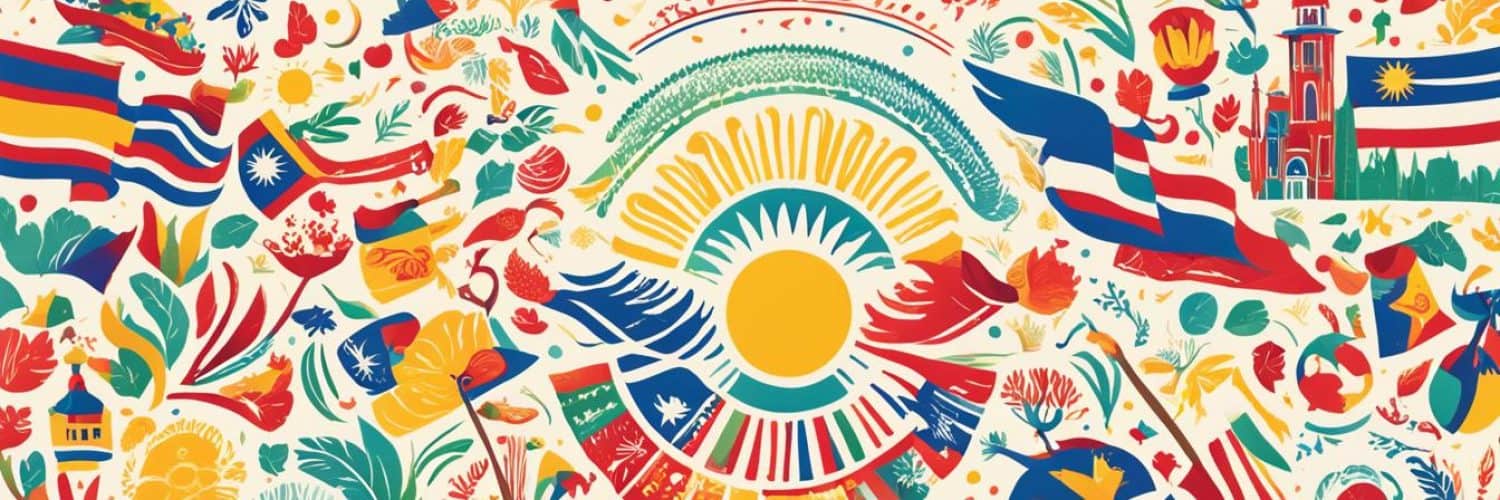Did you know the Philippines has over 180 live languages? This makes it a melting pot of cultures and languages. But among these, one main language brings the nation together. Let’s explore this main language and learn about its rich heritage.
Key Takeaways:
- The Philippines boasts a linguistic diversity of over 180 live languages.
- The main language in the Philippines is Filipino, based on Tagalog.
- English is also an official language and widely used in government and education.
- Spanish has had a significant influence on the Filipino language.
- The Philippines celebrates linguistic diversity during Buwan ng Wika or Language Month.
Linguistic Diversity in the Philippines
The Philippines is known for its vast linguistic diversity, boasting 183 active languages. The country’s geography, featuring 7,641 islands, and diverse cultures contribute to this. Indigenous and regional languages play a big role.
It’s likely that two random people in the Philippines speak different languages. This fact highlights the country’s rich linguistic scene. It ranks among the most diverse countries language-wise.
“The linguistic diversity of the Philippines is a testament to the country’s rich cultural heritage and the resilience of its diverse communities.”
Linguistic diversity shines during Buwan ng Wika or Language Month, every August. This celebration recognizes the many Philippine languages, promoting unity and appreciation.
The Historical Significance of Language Diversity
The Philippines’ languages are steeped in history. They show the impact of indigenous cultures and outside influences. Colonization, trade, and cultural exchanges have all left their marks.
The indigenous languages reflect the country’s rich cultural mosaic. Geographical isolation and unique history helped preserve these languages. They are key to the Philippines’ linguistic heritage.
Preserving and Promoting Language Diversity
Linguistic diversity is a source of pride but also brings challenges. Urbanization and globalization favor dominant languages. This threatens indigenous languages.
Efforts to save endangered languages include government, education, and community projects. This involves documenting languages, producing materials, and promoting bilingual education. These help keep languages alive for the next generations.
| Language Name | Number of Speakers |
|---|---|
| Cebuano | Over 20 million |
| Ilocano | Approximately 7 million |
| Waray-Waray | Approximately 3 million |
| Bikol | Approximately 2.5 million |
To keep these languages alive requires teamwork among indigenous folks, linguists, and stakeholders. By working together, the rich languages and culture of the Philippines can be protected.
Official Languages of the Philippines
The Philippines is rich in languages, with two official ones: Filipino and English. Filipino comes from Tagalog, spoken in Manila. Thanks to its time as an American colony, English is also official. It’s used in government, schools, and media. Both languages help unite the country’s many linguistic groups.
Filipino expands on Tagalog and became the national language in 1987. It’s used in government, education, and the media. As a common language, it helps people from different areas communicate.
English sticks around due to history and its global role. The American English influence means many in the Philippines speak it well. It’s the language for schools, businesses, and talking to the world. English helps in education and international dealings.
Filipino and English show the Philippines’ rich culture and global ties. They link the country’s varied linguistic communities, promoting unity and understanding.
Tagalog: The Foundation of Filipino
Tagalog is the native language in Manila, the capital of the Philippines. It forms the basis of the Filipino language, the nation’s official speech.
As a member of the Austronesian family in the Central Philippine group, Tagalog shares features with Cebuano and Hiligaynon. This link enriches the linguistic variety of the Philippines.
About 14 million people speak Tagalog natively. It’s the second largest language group in the nation. Tagalog’s influence spreads from the capital, making its words and phrases known to many.
Tagalog Vocabulary Examples:
“Kumain na tayo.” – Let’s eat.
“Mahal kita.” – I love you.
“Salamat po.” – Thank you.
Tagalog has a rich heritage and broad use. It’s key in developing the Filipino language and fostering national unity and identity.
Tagalog Language vs. Filipino Language
While Tagalog is the Filipino language’s base, Filipino has evolved. It includes words from other Philippine languages, Spanish, English, Chinese, and Malay.
In 1987, the national language was named Filipino to show inclusiveness. Filipino and Tagalog are similar enough to be used interchangeably.
Both languages are culturally significant. They help preserve the Philippines’ rich heritage and history.
Major Tagalog Language Varieties:
| Region | Variety |
|---|---|
| Region 1 | Ilokano |
| Region 3 | Kapampangan |
| Region 4A | Caviteño |
| Region 5 | Tagalog Rinconada |
| Region 6 | Hiligaynon |
The Tagalog language continues to be a vital part of the Philippines’ linguistic diversity. It strongly influences the Filipino language.
Filipino vs. Tagalog: Are They the Same?
Filipino and Tagalog are often thought to be the same. But they have some differences. Filipino is a modern version of Tagalog. It includes parts from other Philippine languages and foreign languages like Spanish and English.
It changed its name from Tagalog to Filipino in 1987. This was to show it includes more than just Tagalog language.
Tagalog became the national language in 1937. Though their names changed, Filipino and Tagalog are still very similar. They are easy to understand in daily talks.
“The renaming of Tagalog to Filipino in 1987 was a significant step toward recognizing and embracing the cultural and linguistic diversity of the Philippines.”
Adding other languages makes Filipino more inclusive. It represents the country fully. This helps build a strong national identity in a place with many languages.
Although Filipino and Tagalog are close, they are not the same. Tagalog is the language of Manila. Filipino, however, includes a broader mix of influences.
English in the Philippines
English is an official language and a key medium of instruction in the Philippines. It has been widely spoken since the American colonial period. Today, the country is known for its high level of English proficiency.
English is crucial in business, tourism, and education. Its role in these areas has helped the BPO industry grow. The Philippines is now a top choice for call centers and other outsourced services.
The Filipinos’ skill in English has boosted the BPO sector. The EF English Proficiency Index shows the Philippines as a top English-proficient country in Asia. This proficiency plays a big part in the BPO industry’s success.
“English opens doors and opportunities for Filipinos, allowing them to excel in international business, travel, and education. Its widespread usage has become an integral part of the Filipino identity.”
Filipinos see English as a key global language. They aim for fluency in speaking and writing. English learning is a priority in schools. Employers highly value this proficiency.
English Proficiency and Economic Growth
English skills in the Philippines boost the economy and global competitiveness. Foreign investments, especially in the BPO industry, are attracted by the workforce’s education and English abilities.
The BPO sector is vital for the Philippines’ economy. It creates jobs and grows the GDP. The success is due to high English proficiency and quality service to international clients.
English Education in the Philippines
English education starts in elementary school and is key through higher education. Exams like the TOEIC and IELTS are important for students and professionals.
There are also language schools for local and international students. They offer courses to improve English speaking, listening, reading, and writing skills.
English in Daily Life and Media
English is part of daily life in the Philippines. It is in conversations, signs, and media. Many English words have become part of the local language.
English is also big in Filipino media. TV shows, movies, and music in English are popular. They help Filipinos stay familiar with the language.

Spanish in the Philippines
The Philippines was under Spanish rule for 300 years. This period left a big mark on the country’s language and culture. Even though not many people speak Spanish now, its effect is seen in Filipino.
Today, around 0.5% of Filipinos speak Spanish. This makes the Philippines the top country for Spanish speakers in Asia. It shows the strong historical link with Spanish.
Spanish words are part of the Filipino language. Many common words and phrases in Filipino come from Spanish. This mix of languages highlights the connection of their histories and cultures.
“The Spanish language has left an indelible mark on Filipino culture, including not just vocabulary, but also traditions, cuisine, and customs. It serves as a reminder of our complex history and the interplay of various influences in shaping our national identity.” – Dr. Maria Cristina Rodriguez, Language Historian
In the Philippines, you will find Spanish names and surnames. They reflect the era of Spanish colonization and its influence on identity. This shows Spain’s impact on personal and family names.
The Spanish language has shaped Filipino culture, language, and identity. Its influence is a part of the Philippines’ rich and diverse past. Spanish is a key thread in the Filipino society fabric.
Indigenous and Endangered Languages
The Philippines is rich in indigenous languages. These languages are crucial to the cultural identity of various communities. Sadly, many are at risk of vanishing.
There have been efforts to save these languages. These include making materials, documentation, and teaching programs. These help keep the languages alive in their communities.
Yet, modern life poses a challenge. The younger people often choose global or widely spoken languages. This is due to new social trends and job chances.
“Languages are not just a means of communication; they are also repositories of knowledge, culture, and identity. The loss of any language is a loss for humanity.”
The Importance of Preserving Indigenous Languages
Preserving indigenous languages is vital for:
- Promoting cultural diversity
- Safeguarding intangible heritage
- Preserving traditional knowledge
- Fostering a sense of identity and belonging
- Strengthening intergenerational bonds
Through preserving these languages, the richness of Philippine culture stays alive.
Examples of Endangered Indigenous Languages
| Indigenous Language | Region | Number of Speakers |
|---|---|---|
| Aklanon | Aklan | Less than 50,000 |
| Kinaray-a | Western Visayas | Approximately 380,000 |
| Kapampangan | Pampanga | Approximately 2 million |
| Tausug | Sulu Archipelago | Approximately 1.5 million |
Here are just a few examples of the Philippines’ endangered languages. Each one has its own cultural flavor and linguistic wealth.
It’s crucial to protect these languages, for both the local folks and a diverse world.
Language Education in the Philippines
The Philippines has a deep focus on teaching two main languages: Filipino and English. Filipino is the main language for lessons. English is taught too because it’s essential worldwide.
**Learning languages in the Philippines** offers rich and varied experiences. Besides Filipino and English, people can learn Spanish, Mandarin, or Korean. There are many language schools with different courses.
**English proficiency** is very important in the Philippines. It’s especially valuable in the business and tourism areas. Knowing English well can open many doors, both in the country and abroad.
“Language education in the Philippines plays a crucial role in fostering **language skills** that are essential for communication, personal growth, and career advancement.” – Department of Education, Philippines
There are also **language courses** for those who want to improve their skills. These courses suit various needs and preferences. They help people get better at languages and understand more cultures.
The Philippines’ focus on language learning shows its aim to prepare people for the global scene. It also shows a respect for cultural diversity.
Benefits of Language Education in the Philippines
Learning languages in the Philippines has many advantages. These include:
- Improved communication skills in Filipino and English
- Enhanced global competitiveness
- Greater cultural appreciation and understanding
- Expanded career opportunities in various industries
- Improved intercultural communication and relationships
Language Learning Resources in the Philippines
The Philippines offers great resources for those wanting to learn languages. These resources include:
- Language schools and institutions offering structured courses
- Online platforms and apps for self-study and interactive learning
- Language exchange programs and cultural immersion opportunities
- Access to authentic language materials such as books, newspapers, and multimedia
For those interested in Filipino, English, or other languages, the Philippines supports your learning journey. It’s a place that encourages growing your language skills and exploring.
Choosing to learn any language in the Philippines helps with communication and cultural understanding. It leads to personal growth. Diving into the country’s language diversity brings new experiences and chances.
Language Learning Opportunities in the Philippines
The Philippines offers many ways to improve your language skills. You can choose from in-person classes or online courses. Each option is designed to fit your needs.
Cities like Cebu, Manila, and Baguio are great for students wanting to learn English in the Philippines. These places have accredited schools with skilled teachers and the latest facilities. The welcoming atmosphere in these cities also helps in learning.
For those who like learning at their own pace, online courses are available. There are language courses, including English, that you can take from anywhere. These courses offer a well-organized curriculum and interactive materials.
Language learning is more than just grammar and vocabulary. It’s about diving into the culture and talking with native speakers. The Philippines gives you a chance to use your language skills in real situations. This helps you become fluent and understand the culture better.
The Philippines is known for its excellent English proficiency. This makes it a top choice for learning languages. The programs are affordable and meet international education standards. Studying here can be a valuable and exciting experience.
No matter if you learn in-person or online, the Philippines has a lot to offer. With skilled teachers, modern facilities, and a supportive environment, you can reach your language goals. Plus, you get to experience the Philippines’ colorful culture.

Major Native Languages in the Philippines
Apart from Tagalog, the Philippines has many major native languages. These languages are spoken by millions across various regions. They add to the country’s rich language diversity.
Cebuano
Cebuano is mainly spoken in the Visayas. It has over 20 million speakers. This makes it one of the most spoken languages in the Philippines. It’s unique from other languages in vocabulary and grammar. Cebuano is also called Bisaya.
Ilocano
Ilocano is spoken mainly in the north, especially in the Ilocos Region. It stands out due to its phonology and vocabulary. With many speakers, Ilocano is a major language in the Philippines.
Waray-Waray
Waray-Waray is the language of the Eastern Visayas. It’s spoken in Samar and Leyte. About 3 million people speak it. This language is known for being melodic and rhythmic.
Bikol
Bikol is used in the Bicol Region, covering several provinces. It has a complex verb system and unique pronunciation. Bikol adds to the area’s linguistic richness.
These languages, along with Tagalog, are key to the Philippines’ cultural identity. They showcase the diverse heritage and make the Philippines unique.
Challenges and Preservation of Native Languages
The Philippines face a challenge in preserving native languages. Urban and global influences make people prefer common languages over native ones. But, there’s hope. Government programs and groups are working hard to keep these languages alive and kicking.
Getting indigenous communities involved is key. They help by sharing their knowledge and traditions. This teamwork helps keep the Philippines’ cultural and linguistic diversity alive and well for everyone to cherish.
The preservation of native languages is not just about linguistic diversity; it is about the preservation of cultural heritage and identity.
Still, the road ahead is tough. Rapid urban growth makes younger folks lean towards globally recognized languages. This trend threatens native languages. Thus, we must keep trying to turn this around.
The Role of Indigenous Communities
Indigenous communities are vital in saving native languages. They possess a wealth of knowledge and guard their languages closely. By leading programs themselves, they encourage speaking, learning, and practicing cultural traditions.
- Language documentation: Recording and documenting native languages are crucial for their preservation. Oral traditions, stories, and songs are collected and archived, ensuring that the linguistic heritage is preserved for future generations.
- Language materials: The development of language materials such as dictionaries, textbooks, and digital resources helps in the teaching and learning of native languages. These materials provide a foundation for language revitalization and preservation efforts.
- Educational programs: Community-led language immersion programs and language classes are essential for creating an environment where native languages are valued and passed down to younger generations. These programs focus on teaching both language skills and cultural knowledge.
A Multidimensional Approach
A lot of groups need to work together to save native languages. This includes the government, non-profits, schools, and everyday folks. Everyone has a role in keeping these languages around.
Language diversity is a testament to the rich cultural tapestry of the Philippines. Preserving native languages is essential for maintaining this tapestry and fostering cultural understanding and pride.
Government support and policies make a big difference. They fund initiatives and recognize native languages as national treasures. This helps keep the preservation efforts going strong.
Non-profits and schools also pitch in. They provide resources, training, and support to communities. This teamwork leads to effective and lasting ways to save languages.
Continuous Efforts for Language Preservation
Preserving native languages is a never-ending task. Events and festivals that celebrate these languages boost awareness and appreciation. They show everyone why these languages matter and encourage their use.
Also, technology is super helpful. It can be used for documenting languages, creating online resources, and more. Tech makes these languages accessible to even more people.
It’s on all of us to help preserve native languages. Through teamwork, learning, and new methods, these languages can not only survive but flourish. Let’s all take pride in this mission, for the sake of future generations in the Philippines.
| Challenges | Solutions |
|---|---|
| Urbanization and globalization leading to preference for widely spoken languages | Community-led language preservation initiatives |
| Diminishing usage and importance of native languages | Government support and policies for language preservation |
| Declining language transmission to younger generations | Educational programs and community-led language immersion |
| Lack of resources and funding for language preservation | Partnerships with non-profit organizations and educational institutions |
Translation and Language Services in the Philippines
In the Philippines, many languages are spoken. Access to good translation and language services is key for communication. Companies like CCJK are important, offering many translation services in different languages.
CCJK works with languages like Filipino, English, Spanish, and indigenous ones. They have skilled translators. They make sure translations are accurate and respect the culture for businesses, government, and people.
More people need translation services as the Philippines talks more with the world. Communication is vital both locally and worldwide. Good translation services help people understand each other across languages.
Benefits of Translation Services in the Philippines
Translation services help many in the Philippines:
- Effective Business Communication: They let businesses reach more people and grow their markets. A well-translated website or documents improve talks with customers, partners, and investors.
- Legal and Government Support: They’re important for legal stuff. They make sure legal papers and forms are translated right. This helps people deal with laws and government.
- Enhanced Cultural Understanding: Good translations connect different cultures. They help people appreciate other cultures more. People can enjoy literature, media, and more in their language.
Language Services in the Philippines
There’s more to language services than just translations in the Philippines:
- Interpretation Services: Needed for events where real-time translation is needed. Good interpreters help everyone understand each other well.
- Language Training: Programs for those who want to learn or get better at languages. It’s for personal and professional growth in English, Filipino, Spanish, and more.
“Translation and language services are crucial in the Philippines due to its linguistic diversity. They help in communication, understanding different cultures, and in economic and social interactions. With the world getting more connected, the need for precise and trustworthy translations is rising.”
Translation Services Offered by CCJK
| Language | Translation Services |
|---|---|
| Filipino | Document translation, website localization, proofreading/editing |
| English | Localization, transcription, subtitling, voice-over |
| Spanish | Certified translation, legal translation, medical translation |
| Indigenous Languages | Translation/interpretation services, cultural adaptation |
CCJK offers a wide range of translation services, meeting the Philippines’ diverse language needs. Their expertise in Filipino, English, Spanish, and indigenous languages ensures precise and culturally aware translations. This boosts effective communication across different areas.
Conclusion
The Philippines shines with its rich culture and languages. Filipino, based on Tagalog, is the main language, with English as an official one too. This country is home to over 180 living languages, reflecting its broad linguistic diversity.
There’s a strong effort to keep indigenous languages alive, despite modern challenges. By promoting and documenting these languages, the Philippines safeguards its cultural heritage for the coming generations.
Learning languages is crucial in the Philippines. The country offers various language programs and schools. People can learn Filipino, English, Spanish, and other languages, improving their skills and understanding other cultures.
Translation and language services are key in this diverse nation. They ensure clear communication across different languages and cultures. These services help businesses, government, and people connect and work together globally.







Add comment